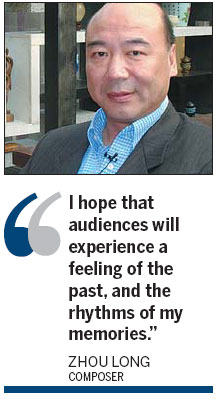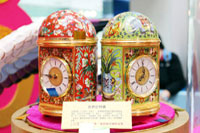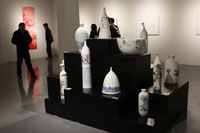When the composer Zhou Long was a child, he lived in a traditional courtyard home at the foot of Beijing's bell and drum towers. Twisting the wooden handle of a small rattle-drum as he played with his sister on winter afternoons, he beat a whirring rhythm and wondered what the towers might have sounded like when they still told the time.

Built in 1272 during the Yuan Dynasty (1271-1368), the towers had once housed 25 drums and the largest bell in China. Several times a day, the noise from them announced the passage of the hours. The structures have remained silent since 1924, when the last emperor of the Qing Dynasty (1644-1911) was forced to leave the Forbidden City.
"During my childhood, there was no sound," Zhou says. "The towers were silent. I would walk by and feel so much curiosity about these towers. I thought about that huge bell just sitting there on the ground, and I would let myself imagine."
On the night of Jan 18, in the US debut of a new work, Bell Drum Tower, the Pulitzer Prize-winning composer recalled how he conjured those iconic buildings in a performance by the American Composers Orchestra at Carnegie Hall in New York.
Led by ACO music director George Manahan, the piece was presented as part of Orchestra Underground: Time Travels, a concert centered on the exploration of "the concept of time - its mutability, importance and role as an organizing principle", according to an ACO release.
Bell Drum Tower was commissioned by the House of World Cultures for the Ensemble Modern, and premiered in Berlin in 2006.
In addition to Zhou's composition, ACO performed Lukas Foss' 1960 masterwork Time Cycle with soloist Jennifer Zetlan. Also, the orchestra premiered composer and soprano Kate Soper's Now Is Forever: I. Orpheus and Eurydice and Kyle Blaha's Triptych.
"We wanted to present very different voices in a unified program, around a concept through which the audience could find their own way into a conversation about time," says Derek Bermel, creative advisor of ACO.
"Zhou Long has been on our radar for a long time, and his piece was an obvious choice," Bermel says.
 |
"In drawing on inspiration from these towers, which marked the hours of time but were also musical instruments, Zhou Long has chosen a way to talk about the subject in a way that is uniquely Chinese. Only a Chinese composer could write this piece. But at the same time, it's informed by Western music and his time in the United States."
Zhou, who received the 2011 Pulitzer Prize in music for his opera Madame White Snake, currently teaches at the University of Missouri-Kansas City Conservatory of Music and Dance. He has created works for the Tokyo and China philharmonics, the Kronos and Shanghai string quartets, the New York New Music Ensemble, and musicians Yo-Yo Ma and Lan Shui, among others.
"Zhou Long is one of our great living composers, who happens to be a composer from China," Bermel says. "That's very exciting, because it means a different perspective. He's someone with a dual identity. His work is informed by songs he heard as a kid; he's inspired by Chinese calligraphy, poetry and the modal sounds that he grew up with.
"But in addition to having learned to write for Chinese instruments, he also creates music for Western instruments. He's a hybrid identity. You can't quite call him one thing or another."
Zhou represents a tradition of bringing Chinese culture to the US that dates back to the 19th century, Bermel says.
Since its founding in 1977, ACO has embraced cultural diversity and the artistic richness that results from a mix of heritages, he says. In recent years, a steady stream of Chinese musicians and composers has furthered the classical music tradition.
|
 |
Bell Drum Tower doesn't feature Chinese instruments but draws on Zhou's memories of the towers themselves as well as the frequent festivals in nearby neighborhoods, he says. During holidays, farmers would come from the countryside and magicians would perform for jostling crowds. That bustle of activity beneath the long-silent towers was inspiring, Zhou says.
In the program notes, Zhou writes: "My curiosity and imagination was to hear the lingering sound of the ancient bells and drums, which sometimes would sound with the hazy wind, and sometimes as a peal of thunder. In the Bell Drum Tower, I am exploring my fantasy of their (the towers') sound in the wind, the pulse of drums beating. Gradually, new patterns develop, each time in a faster tempo, building to a climax that brings the music to a presto wind-like section. Finally, the hazy wind (rings) the lingering bells."
Even for listeners who have never been to China or seen the towers, he hopes the piece will evoke "a certain distance in the passage of time".
"I hope that audiences will experience a feeling of the past, and the rhythms of my memories," Zhou says.
kdawson@chinadailyusa.com
|
|
|
|
|
|
